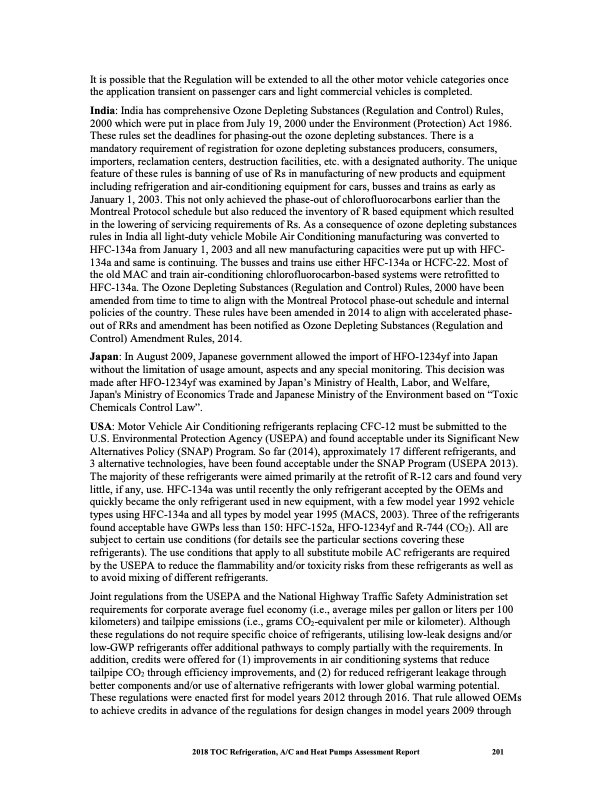
PDF Publication Title:
Text from PDF Page: 214
It is possible that the Regulation will be extended to all the other motor vehicle categories once the application transient on passenger cars and light commercial vehicles is completed. India: India has comprehensive Ozone Depleting Substances (Regulation and Control) Rules, 2000 which were put in place from July 19, 2000 under the Environment (Protection) Act 1986. These rules set the deadlines for phasing-out the ozone depleting substances. There is a mandatory requirement of registration for ozone depleting substances producers, consumers, importers, reclamation centers, destruction facilities, etc. with a designated authority. The unique feature of these rules is banning of use of Rs in manufacturing of new products and equipment including refrigeration and air-conditioning equipment for cars, busses and trains as early as January 1, 2003. This not only achieved the phase-out of chlorofluorocarbons earlier than the Montreal Protocol schedule but also reduced the inventory of R based equipment which resulted in the lowering of servicing requirements of Rs. As a consequence of ozone depleting substances rules in India all light-duty vehicle Mobile Air Conditioning manufacturing was converted to HFC-134a from January 1, 2003 and all new manufacturing capacities were put up with HFC- 134a and same is continuing. The busses and trains use either HFC-134a or HCFC-22. Most of the old MAC and train air-conditioning chlorofluorocarbon-based systems were retrofitted to HFC-134a. The Ozone Depleting Substances (Regulation and Control) Rules, 2000 have been amended from time to time to align with the Montreal Protocol phase-out schedule and internal policies of the country. These rules have been amended in 2014 to align with accelerated phase- out of RRs and amendment has been notified as Ozone Depleting Substances (Regulation and Control) Amendment Rules, 2014. Japan: In August 2009, Japanese government allowed the import of HFO-1234yf into Japan without the limitation of usage amount, aspects and any special monitoring. This decision was made after HFO-1234yf was examined by Japan’s Ministry of Health, Labor, and Welfare, Japan's Ministry of Economics Trade and Japanese Ministry of the Environment based on “Toxic Chemicals Control Law”. USA: Motor Vehicle Air Conditioning refrigerants replacing CFC-12 must be submitted to the U.S. Environmental Protection Agency (USEPA) and found acceptable under its Significant New Alternatives Policy (SNAP) Program. So far (2014), approximately 17 different refrigerants, and 3 alternative technologies, have been found acceptable under the SNAP Program (USEPA 2013). The majority of these refrigerants were aimed primarily at the retrofit of R-12 cars and found very little, if any, use. HFC-134a was until recently the only refrigerant accepted by the OEMs and quickly became the only refrigerant used in new equipment, with a few model year 1992 vehicle types using HFC-134a and all types by model year 1995 (MACS, 2003). Three of the refrigerants found acceptable have GWPs less than 150: HFC-152a, HFO-1234yf and R-744 (CO2). All are subject to certain use conditions (for details see the particular sections covering these refrigerants). The use conditions that apply to all substitute mobile AC refrigerants are required by the USEPA to reduce the flammability and/or toxicity risks from these refrigerants as well as to avoid mixing of different refrigerants. Joint regulations from the USEPA and the National Highway Traffic Safety Administration set requirements for corporate average fuel economy (i.e., average miles per gallon or liters per 100 kilometers) and tailpipe emissions (i.e., grams CO2-equivalent per mile or kilometer). Although these regulations do not require specific choice of refrigerants, utilising low-leak designs and/or low-GWP refrigerants offer additional pathways to comply partially with the requirements. In addition, credits were offered for (1) improvements in air conditioning systems that reduce tailpipe CO2 through efficiency improvements, and (2) for reduced refrigerant leakage through better components and/or use of alternative refrigerants with lower global warming potential. These regulations were enacted first for model years 2012 through 2016. That rule allowed OEMs to achieve credits in advance of the regulations for design changes in model years 2009 through 2018 TOC Refrigeration, A/C and Heat Pumps Assessment Report 201PDF Image | Heat Pumps Technical Options

PDF Search Title:
Heat Pumps Technical OptionsOriginal File Name Searched:
RTOC-assessment-report-2018_0.pdfDIY PDF Search: Google It | Yahoo | Bing
CO2 Organic Rankine Cycle Experimenter Platform The supercritical CO2 phase change system is both a heat pump and organic rankine cycle which can be used for those purposes and as a supercritical extractor for advanced subcritical and supercritical extraction technology. Uses include producing nanoparticles, precious metal CO2 extraction, lithium battery recycling, and other applications... More Info
Heat Pumps CO2 ORC Heat Pump System Platform More Info
| CONTACT TEL: 608-238-6001 Email: greg@infinityturbine.com | RSS | AMP |